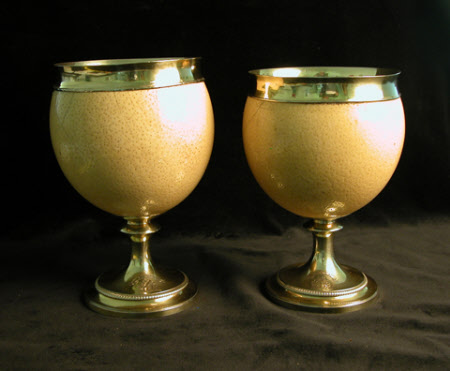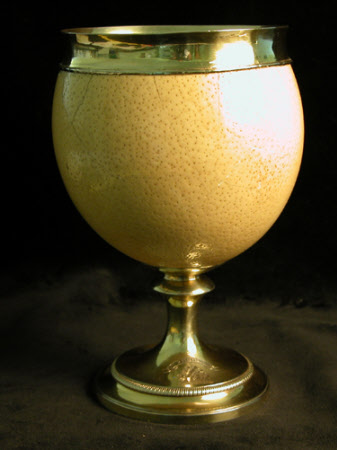Goblet
John Robins
Category
Silver
Date
1811 - 1812
Materials
Silver and shell
Measurements
18.5 x 12.7 cm
Place of origin
London
Order this imageCollection
Anglesey Abbey, Cambridgeshire
NT 516435
Summary
Pair of ostrich egg goblets, silver gilt mounts, circular feet, gadrooned borders, plain lining and lip. Engraved with rocks and motto 'FIRM'. Maker's mark I.R.1811. English.
Full description
NOTES ON OSTRICH EGGS For thousands of years ostrich eggs were revered and traded out of the ostriches natural habitats in Africa to the Middle East and Europe. Decorated examples have been discovered in pre-dynastic Egyptian tombs dating back to the 4th millennium BCE, and in pre-Christian necropoleis in Italy and southern Spain. The ancient Greeks and Romans offered the eggs to their deities and hung them in temples as decorations or lamps. Drawing on their long associations with different religions, the ostrich egg became a Christian symbol of new life, rebirth, and the Immaculate Conception of the Virgin Mary. Whilst medieval Europeans believed that drinking from an ostrich egg would offer protection from poison. Until the mid-17th century ostrich eggs were so rare and exotic in Britain and northern Europe that they were collected by royalty and the wealthy, who had them mounted in silver and silver-gilt. They ranged from a simple rim mount and a foot to an extraordinary tour de force of silversmithing, sometimes set with precious stones. Occasionally the egg was used to form the body of a silver or silver-gilt drinking cup in the shape of an ostrich, or fantastical creature. These treasured objects showed the owner to be both highly cultivated and wealthy. They were important objects for display and could be stored along with other rarities in the owner’s cabinet of curiosities or treasure room, known in Germany as kunstkammer and schatzkammer. As travel increased and ostrich eggs became more readily available, their exoticism – almost mysticism – decreased, and their desirability declined. By the 18th century silversmiths were rarely asked to mount ostrich eggs. This would have been an unusual commission for John Robins, although he had previously mounted Chinese and Japanese porcelain bowls for the collector William Beckford. HERALDRY This combination of crest and motto can be found for several, but not all, branches of the Dalrymple family. Jane Ewart, 2025 Heraldry by Gale Glynn
Provenance
Bequeathed to the National Trust by Huttleston Rogers Broughton, 1st Lord Fairhaven (1896-1966) with the house and the rest of the contents.
Credit line
Anglesey Abbey, the Fairhaven Collection (National Trust)
Makers and roles
John Robins, goldsmith

